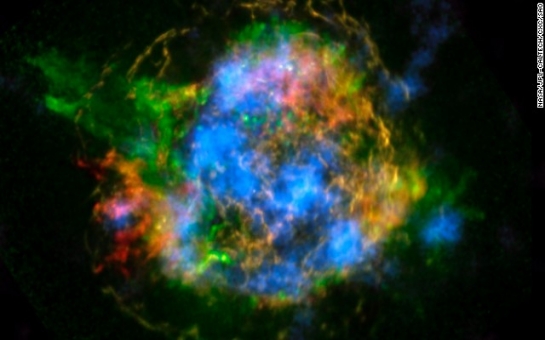And thanks to NASA space telescopes, scientists are learning more than ever about exactly how it happened.The NuSTAR space telescope array is the first to map the radioactive material from a supernova explosion. The results were published Wednesday in the journal Nature."Until we had NuSTAR, we couldn't see down to the core of the explosion," Brian Grefenstette, lead author and research scientist at the California Institute of Technology, said at a news conference Wednesday.NuSTAR's observations of Cassiopeia A showed scientists the location and distribution of radioactive titanium-44, an unstable isotope with a half-life of about 60 years. The supernova explosion's light arrived on Earth about 350 years ago, but even today there's still plenty of titanium-44 to be observed.Each atom of titanium-44 decays to calcium, as well as two particles of light at particular frequencies that NuSTAR can detect. NuSTAR, which stands for Nuclear Spectroscopic Telescope Array, launched in June 2012 and consists of an instrument with two telescopes that focus high energy X-ray light.There's currently no solid model for how the supernova explosion process actually works, Grefenstette said. Scientists would like to know more, especially because the components of our planet came from a supernova that blew up about 5 billion years ago."People should care about supernova explosions because that's where all the stuff that makes us comes from," Grefenstette told CNN. "All of the iron in your blood and calcium in your bones and teeth, and gold in your wedding band, that all comes from the center of a supernova explosion."The map of the radioactive ash that NuSTAR studied is akin to a "fossil record," Grefenstette said. It is an imprint of what happened in the explosion, and it is helping astronomers rule out previous ideas about how stars explode.So here's what scientists think is happening: At the center of the supernova, an intense amount of pressure builds up. Neutrinos, tiny particles, are produced and heat up the gas in the center."What you get is just like when you're boiling water on your stove top: You get hot bubbles at the bottom that try to rise up through the cold material above it, and the whole thing starts to slosh around," Grefenstette said.Big "bubbles" form in this process, and the whole thing starts to fall apart, he said."It's like blowing the top off a pressure cooker, and the shock wave rips apart the star," Grefenstette said at the news conference.The NuSTAR observations suggest that these large bubbles are present at the center of the star, a phenomenon that had been thought about through computer models but never observed.The new study finds evidence for the bubbles forming in the first fraction of a second of the explosion."It's like you blink your eyes twice, and the whole thing has exploded, and we're seeing it three or four hundred years later, preserved in the radioactive ash," Grefenstette said.Researchers describe this explosion process as "asymmetrical" because according to their modeling, temperatures and densities must be different around the explosion in order for the "bubbles" to escape and let the shock wave out.Scientists aren't ready to say definitively that this "sloshing" model of supernova explosion caused Cassiopeia A to blow apart, but the evidence supports that theory, Grefenstette said.Cassiopeia A, a well-studied celestial object, is about 11,000 light years away. That means technically, it exploded more than 11,000 years ago, but because of its distance from us, we only could have learned about it about 350 years ago.It's unlikely that any Earthlings observed it back in the 17th century, however, because of the amount of dust between our planet and the supernova explosion. There is a record of a new star charted by a British astronomer around the time the supernova's light should have reached us, but it's controversial, because that star is not in the place in the sky where Cassiopeia A would have been.The Hubble Space Telescope has examined the supernova's optical light, and the Chandra X-ray Observatory looked at its low-energy X-rays. The radioactive ash is available for the first time to NuSTAR, which can detect high-energy X-rays.NuSTAR has also given scientists a new mystery to ponder about supernovas. They expected the radioactive titanium map to match the map of iron, because those elements are thought to have been created in the same place of the explosion. Instead, their distributions are very different.This may mean that that there is more iron that hasn't been seen yet or that there is something completely different that generates elements."NuSTAR is living up to its name way in two ways," Robert Kirshner, an astronomer at the Harvard-Smithsonian Center for Astrophysics who was not involved in the study, said at the news conference. "It's not just nuclear, but it's new."(CNN)ANN.Az
Supernova secrets seen in X-rays
Society
22:31 | 20.02.2014

Supernova secrets seen in X-rays
Cassiopeia A was a star more than eight times the mass of our sun before it exploded in the cataclysmic, fiery death astronomers call a supernova.
Follow us !










